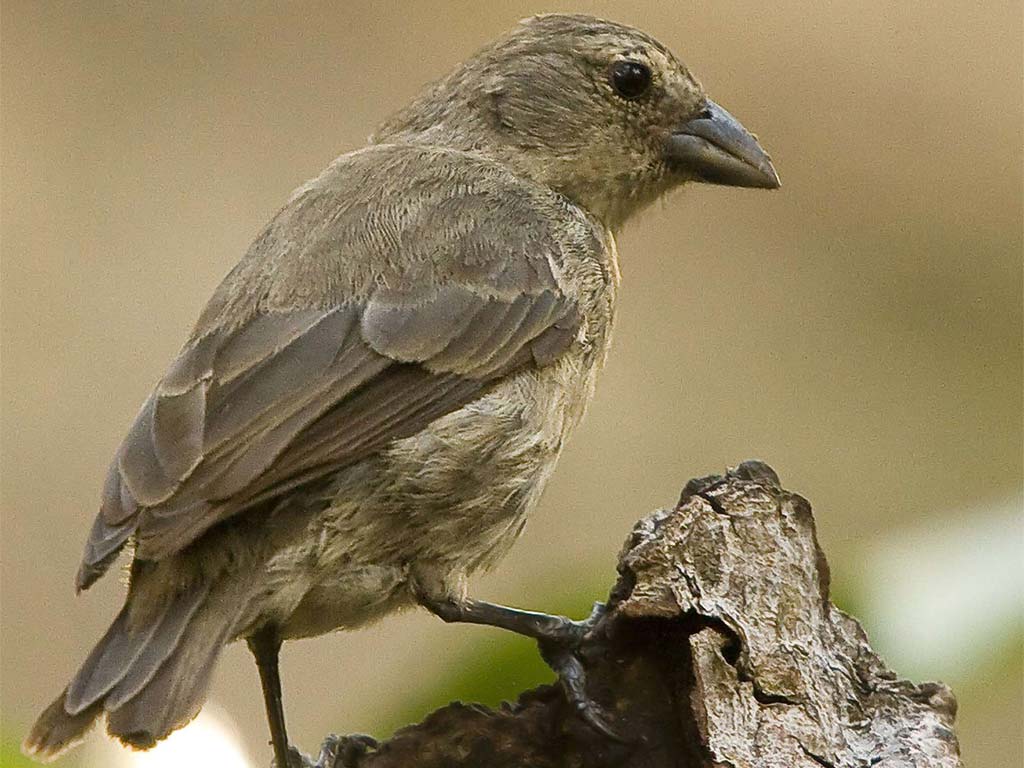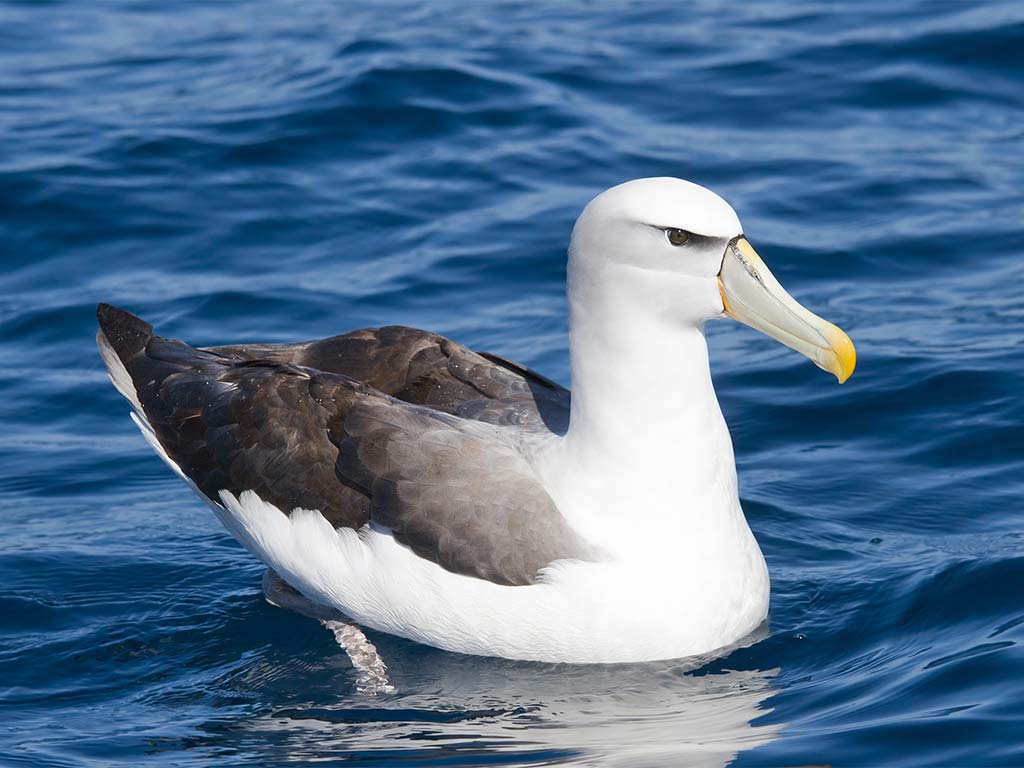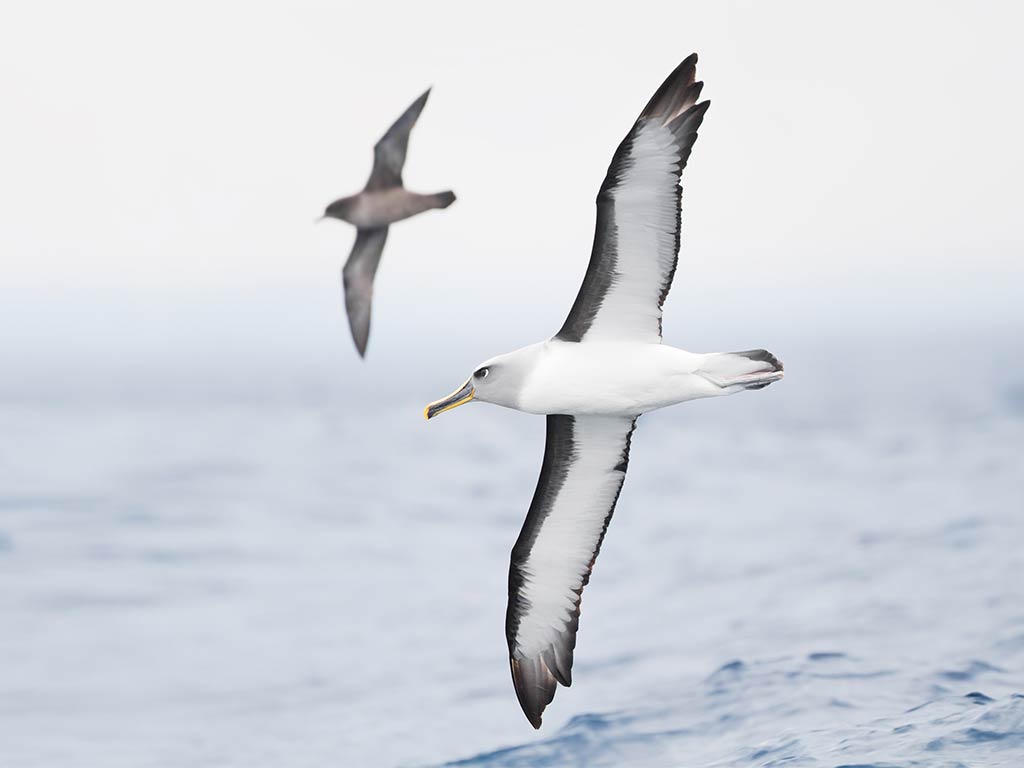Birds

Galapagos 2015: Year in Review
December 31, 2015
We have made leaps and bounds with conservation efforts in Galapagos this year, from restoring giant tortoise populations to protecting mangrove finches from extinction. Here are a few of our favorite stories from 2015.
February–April 2015: A Successful Second Year for Mangrove Finch Conservation
In February, mangrove finch eggs were collected from a small mangrove forest at Playa Tortuga Negra on Isabela Island for the second consecutive year in an attempt to protect this critically-endangered species from extinction. When the eggs hatched in March, eight fledglings were reared in captivity at the Charles Darwin Research Station on Santa Cruz, and in April researchers successfully released the chicks back in their natural mangrove forest on Isabela. With a total population size of less than 100 individuals, this program is an important effort to protect and boost the mangrove finch population in Galapagos.
May 2015: Wolf Volcano Erupts for the First Time in 33 Years
The highest peak in the Galapagos Archipelago, Wolf Volcano on the northern end of Isabela Island, erupted on May 25, 2015 after 33 years of inactivity. Scientists were initially concerned about the safety of the world’s only population of pink land iguanas, which share habitat on the volcano with yellow land iguanas and giant tortoises. Thankfully, the lava flowed in the opposite direction and wildlife were minimally impacted. GC's Wacho Tapia participated in a fly-over to help assess the situation with a team from the Galapagos National Park Directorate.
Also in May 2015: GC Signs Cooperative Agreement with the Government of Ecuador
Galapagos Conservancy's President Johannah Barry signed a cooperative agreement with the Ecuadorian Technical Secretariat of International Cooperation, known as SETECI, its acronym in Spanish. The agreement outlines broad areas of work in advancing research, science, and innovation related to the conservation of the unique ecosystems and biodiversity of Galapagos. Working more closely with the Government of Ecuador is an important component of GC's ability to impact the long-term protection of the Islands.
June 2015: 201 Tortoises Released on Santa Fe Island
On June 27, 2015, a group of 30 rangers, scientists, and staff from the Galapagos National Park Directorate and Galapagos Conservancy transported 201 young Española tortoises from the Santa Cruz Breeding Center to Santa Fe Island, marking the first time tortoises roamed Santa Fe in more than 150 years. Two months later, scientists returned for a monitoring trip and were able to locate 142 of the 201 released tortoises — and found that all were in excellent physical condition. Future trips are planned to continue to monitor the health and activity of the tortoises. Watch the video of the release.
September 2015: Transforming K-12 Education in Galapagos
GC's Director of Strategic Partnerships, Richard Knab, has been working with the Ecuadorian Ministry of Education on an intensive teacher training program in Galapagos to help address the need for quality education, which is critical to building a society in which local residents are committed to the long-term protection of the Islands. In September, Richard traveled to Galapagos with members of the program's Math Advisory Team from Teachers-to-Teachers International during which they observed classrooms, met with school directors, and provided innovative teacher training to all elementary school teachers and all middle school and high school math teachers on the island of Santa Cruz. Working closely with the Ecuadorian Ministry of Education and an international network of education experts, they are developing what could become the most intensive and comprehensive teacher training program ever implemented in Latin America. Full launch of the program, which will benefit every student (7,500 in total) from every school (22 in total), is planned for April 2016.
October 2015: A New Giant Tortoise Species is Named
Two tortoise populations have existed on Santa Cruz Island for as long as anyone can remember, and it was always assumed that they belonged to the same species. But the results of recent genetic analyses have clearly identified them as separate, distinct species: The Western Santa Cruz Tortoise, and the newly named Eastern Santa Cruz Tortoise (Chelonoidis donfaustoi). The new species was named in honor of long-time Galapagos National Park Ranger Fausto Llerena Sánchez (“Don Fausto”) who dedicated 43 years of service to conservation with the Galapagos National Park.
November 2015: Galapagos Thanks You
Thank you for helping us successfully fulfill our conservation goals in this extraordinary archipelago in 2015! In November, our partners and collaborators in Galapagos expressed their gratitude to our donors. View the video.
November–December 2015: Wolf Volcano Expedition Collects 32 Tortoises to Establish Breeding Populations
On November 18, 2015, a group of more than 40 scientists, technicians, and rangers from the Galapagos National Park Directorate embarked on a ten-day expedition led by GC's Wacho Tapia, Director of the Giant Tortoise Restoration Initiative, to search for tortoises living on Wolf Volcano with a high percentage of genes from the extinct Pinta and Floreana tortoise species. From more than 1,000 tortoises found, a total of 32 tortoises were transferred to the Tortoise Center on Santa Cruz for potential use in a breeding program to eventually repopulate Pinta and Floreana with tortoises. Genetic analyses are currently being conducted to reveal the ancestry of each individual tortoise collected during the expedition, Genetic analyses are currently being conducted to reveal the ancestry of each individual tortoise collected during the expedition, as well as of 148 additional tortoises sampled on the volcano during the expedition for subsequent genetic analysis. None of these developments or discoveries would be possible without the generosity of our members and partners — thank you all for your support, and Happy New Year!

Española Part 2: Counting Albatross and Measuring Cactus
June 1, 2015
By guest author Dr. James Gibbs of the State University of New York’s College of Environmental Science and Forestry (SUNY-ESF).
The seas finally calmed sufficiently to allow us to head to Española. After two hours on a speed boat, we — Wacho Tapia, park rangers Carlos Vera and Carlos Gaona, Novarino Castillo, and myself — step ashore at Playa Manzanillo on the north central coast. Carrying our gear up the beach, we are delighted to see sea turtle hatchlings emerging from their nests. They “flipper” their way down the beach, get scooped up by a wave that throws them back, then “flipper” on down again. As these little guys head off so earnestly for their new life in the big blue ocean, I wonder: will the hatchling I am watching be the 1 in 1,000 that makes it to maturity?
After eating a quick lunch of rice with canned tuna and a dash of hot sauce, we pack up and head inland into the scrub, loaded with gear and food for four hungry men for six days. Novarino will stay camped on the beach and make a daily trek to our camp to resupply us with water. As we climb, we encounter dense, lush vegetation, a rare sight on this normally arid island, a result of recent heavy rains. We come across a long winding track with the vegetation plowed flat — sign of a giant tortoise. Seeing this so close to the beach and far from prime tortoise country is rare; proof these animals, released on Española as part of the decades-long tortoise repatriation program of the Galapagos National Park Directorate, are expanding their range, especially when conditions are lush.
After two hours, we arrive at our first tortoise exclosure — 24 meters of chain-linked fence surrounding a huge spreading tree cactus. These exclosures constructed two years ago by men from the highlands of Santa Cruz were built to last. Inside the exclosure, we find numerous cactus pads and fruit on the ground that would normally be vacuumed up by tortoises; this was expected. But there was also an unexpected pronounced shift toward herbaceous plants (that is, not grasses). Over the next two days we measure plants in all exclosures but the changes are obvious. Clearly tortoises can shift plant communities over short periods as can the absence of tortoises — evidence that tortoises are important for ecological reasons alone. We are eager to digitize our 30 pages of grubby field sheets of numbers to extract patterns of change.
We camp at El Caco, on the saddle that defines the top of the island. El Caco is a magnificent and massive lone Erythrina velutina tree. Although native to Galapagos, this is the only one known on the island; it was likely a favorite forage species of the once present introduced goats. We settle in under its spreading branches as darkness falls.
Wacho asks about the pirates that collected tortoises here; what trails did they use? Who else might have sat under this very Caco tree (it must be at least 200 years old)? What did they talk about? This island experienced pirates, whalers with odd accents, then Spanish-speaking fishermen. The first park rangers arrived in the 1970s to kill the goats that had infested the island, remove the few remaining tortoises, and eventually return the young tortoises produced in the breeding center on Santa Cruz. Now we sit under the same tree, likely having many of the same conversations.
We spend several days measuring the plants in the tortoise exclosures and controls (unfenced plots). One day, with machetes in hand, we make our way through the dense vegetation over the top of the island to the “central colony” of waved albatross, a colony that was considered extinct by some - but not so! Large numbers of albatross remain scattered throughout. We trek down to the sloping nesting zone to count albatross around the “albatross airstrips” — long open avenues through dense woody vegetation that allow the massive birds to land and take off. One bird tries five times, but each time the wind weakens and it crashes down again. We count albatross in the five clearings we created two years ago. However, the heavy rains have flooded many nests and numbers are down. “Crunching the numbers” will tell us if albatross prefer the human-made clearings.
One morning, loud thunder stops us before we head out, followed by a two-hour downpour. When the rain lets up, we slog back into the field. We can hear a rushing stream and waterfalls pouring over the cliffs. At times we walk hip-deep in water. We complete our final task for the trip-marking cactus for long-term monitoring. We measure cactus height, note GPS location, and apply a metal tag. The base of a few cactus stand deep in water. Data collected over the next several years will show how the cactus population changes over time.
It is an extraordinary time on Española. Finch songs fill the air, the repetitive groans of mating tortoises resound from all directions, mockingbirds gather nest material, and caterpillars seem to be everywhere. It’s been a productive if wet trip and we look forward to analyzing our data to shake out what has happened inside the tortoise exclosures and on the albatross airstrips. I enjoyed experiencing Española in a rare time of heavy rain — a short interregnum of biological exuberance and reproduction before the austere aridity that normally defines the island sets in yet again and creatures revert to survival mode.
Dr. James Gibbs is Professor of Vertebrate Conservation Biology and Associate Chair of the Department of Environmental and Forest Biology at the State University of New York (SUNY-ESF). He has partnered with Galapagos Conservancy for many years in efforts to restore giant tortoise populations in Galapagos through the Giant Tortoise Restoration Initiative, and is a frequent guest contributor to the GC blog.

Española: Creating Albatross “Airstrips” and More
May 21, 2015
By guest author Dr. James Gibbs of the State University of New York’s College of Environmental Science and Forestry (SUNY-ESF).
Wacho and I are gearing up for a seven-day-long field trip into the middle of Española Island. However, seas are extremely rough (nine-ten foot waves reported) and the port captain is not letting open boats leave the harbor. When the wave size decreases, we will be on our way.
What will we do on Española? First we will measure what is happening inside the fenced tortoise "exclosures" we built surrounding 25 cacti two years ago. These are strong, six-by-six-meter fences well anchored to keep tortoises out. Why build fences to keep tortoises out, you ask? During our work over the years, we have learned that the island is getting progressively more covered by dense stands of woody plants. We don’t know why but it’s likely that the introduced goats, now eradicated, removed all grasses, triggering a major change in which plant species thrive and which do not.
We also need to determine what role tortoises play in all this. Will the introduced and expanding tortoise population help push the woody plants back by flattening and eating them? Or will they actually hasten the expansion of woody plant growth through seed dispersal? The magnificent tree cacti on Española, which were hammered by the goats, are also important. Now the few remaining cactus get much attention from the tortoises, maybe too much as the tortoises eat every bit they can find.
Exclosures are a fabulous way to get a clear understanding about the effects any herbivore has on its ecosystem. In a classic experiment, we initially measured every single plant on the 25 six-by-six-meter-square plots, which involved lots of crawling around on hands and knees, then installed the exclosures on 13 of those plots. We will continue to measure all 25 plots (with and without fences) for at least five years. We’ll have news on this year’s findings when we return from this trip.
Our second objective is to measure the response of nesting waved albatross (globally unique — they only nest on this island) to large brush clearings (pistas or "airstrips") we created in the interior of the south side of the island. Large numbers of albatross still nest in the interior. They must scramble in and out of small open areas for take-off and landing and then walk great distances through the brush to their nest site, although they don’t have developed nests and they roll their eggs around when so inclined.
We believe that these ungainly birds have also suffered from the extensive growth of woody plants due to increased difficulty when landing and taking off. But we don’t really know. In May/June, these birds are incubating eggs. Two years ago we made counts of nesting albatross on ten 50-meter-radius plots scattered through the interior of the island. Then we cut down every single woody plant by hand on five of these plots (hot work!).
Last year we counted nesting albatross. The cleared areas gained five nesting albatross on average, the controls (uncleared plots) none. We’ll repeat the counts on this trip. These are long-lived, site-faithful birds, so we don’t expect them to respond immediately if in fact they do at all. Only time and continued monitoring will tell.
And if we have time, we hope to tag 200 cactus of all sizes to track them long into the future. How well do they grow and survive? Just what is the cactus population doing — declining or expanding? Cactus is critical to so many species on the island — finches that eat the seeds, mockingbirds that peck the pads, insects that take the pollen and nectar, and, of course tortoises that devour every bit of cactus they can find. By tracking what happens to cactus we can get a handle on what the future might bring for this keystone species in this extremely arid, once goat-devastated, now recovering environment.
Together these studies will help us understand if and how much woody plants are a problem for Española Island, how tortoises are shaping the vegetation, and if the critically endangered albatross will benefit from brush clearing. This is part of a larger effort by Galapagos Conservancy to aid the Park in decision-making concerning whether to let the island continue to recover without intervention from the ravages of 100 years plus of goat infestation, or if large-scale habitat management, which could include cactus seeding and brush clearing, is needed to get island restoration back on track.
Dr. James Gibbs is Professor of Vertebrate Conservation Biology and Associate Chair of the Department of Environmental and Forest Biology at the State University of New York (SUNY-ESF). He has partnered with Galapagos Conservancy for many years in efforts to restore giant tortoise populations in Galapagos through the Giant Tortoise Restoration Initiative, and is a frequent guest contributor to the GC blog.

Comments